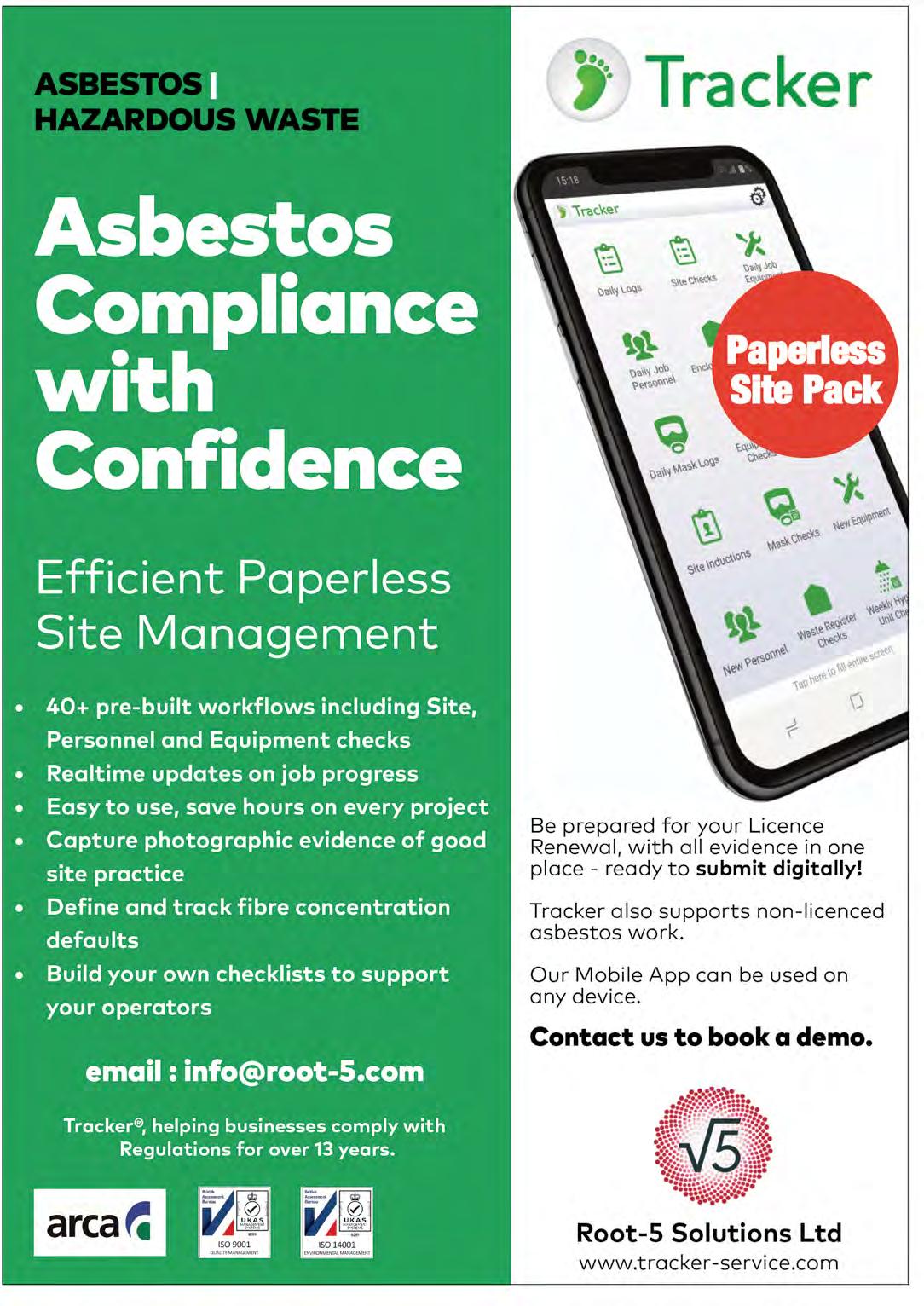
9 minute read
Parliamentary Work & Pensions Committee – Government response
The Health and Safety Executive’s approach to asbestos management: Government Response to the Committee’s Sixth Report of Session 2021–22
The response began with the Government thanking the Work and Pensions Select Committee for its report on the Health & Safety Executive’s approach to asbestos management. The Government then stated that, as a general principle, recognising the serious nature of the risk to death from asbestos, they have to carefully consider the evidence before taking any actions forward. The Government want to continue to reduce deaths from asbestosrelated diseases and that is why ensuring the effective regulation of legacy asbestos remains a key priority for HSE.
Response to some of the recommendations are:
w Central register of asbestos - HSE works with others in government (GDS) to develop a central digital register of asbestos in non-domestic buildings, describing its location and type. In the first instance, the concept of a central register could be tested using asbestos data from public buildings such as schools and hospitals.
HSE provided evidence to the committee that the existing legal requirement set out in the Control of Asbestos Regulations 2012 (CAR 12) requires duty holders to identify and locate asbestos within their premises and share this information with everyone who may possibly, in the course of their work activity, be at risk of exposure to asbestos. HSE’s evidence suggested that a new central register - which would require significant resource from duty holders and government - would duplicate this existing information with no clear indicator that asbestos exposure risks would be improved. Some of the other regulators who provided evidence to the inquiry reflected these as important considerations as part of any development of a register. It could also undermine the active requirement on duty holders to manage asbestos in non- domestic premises on an ongoing basis.

While HSE agrees we should continue to look for opportunities to reduce the risks associated with asbestos, there needs to be confidence the changes to the regulatory burden for duty holders and cost to government, are proportionate to the health benefits that would arise. The Regulators Code also requires that HSE avoids imposing unnecessary burdens on duty holders and bases its regulatory activities on risk.
Fundamental to ensuring awareness of the asbestos exposure risk, is that duty holders understand and actively comply with the law. The duty to manage asbestos and share information on its location with those most at risk is a key part of this.
HSE will develop targeted communications activity to increase awareness and understanding of how to manage the risks and the importance of sharing information. This will form part of its planned activity to support the UK’s net zero agenda; where those most at risk of asbestos exposure are likely to be involved in retrofitting and refurbishment work. HSE will also use information gathered from its planned inspections in 2022/23 to inform activities aimed at influencing improved duty holder compliance in this area.
w Information sharing - HSE strengthens its work with, and guidance to, duty holders to make clear their obligations to communicate asbestos information and risks to building contractors and users.
Ensuring that duty holders are aware of the asbestos legacy in their buildings and actively complying with the law is key to managing the exposure risk to workers. HSE recognises the importance of duty holders actively managing this information and ensuring it is regularly communicated to those who need it most.
During 2022/23, HSE will carry out targeted inspection activity across GB workplaces to check compliance with these important legal duties, to ensure that those most at risk of exposure, such as trades people, are being informed of the location of asbestos before work commences. We will also look to develop our communications activity in this area to support this wider inspection work.
In parallel, HSE will continue its work with duty holders and those in charge of estates strategies for non-domestic buildings, to raise awareness of the legal requirements.
HSE will also progress its shared aims with UKAS, surveyor groups, IOSH, trade associations and training bodies to ensure activity remains focused on ensuring standards and competence are maintained. w Regulatory activity - HSE commits to a sustained increase in inspection and enforcement activity targeting compliance with the Control of Asbestos Regulations.
Repeating our recommendation from June 2020, the
Government and DWP should ensure that it provides adequate funding to HSE to support this increased programme of work over the medium term.
DWP approves HSE’s business plan which includes details of how HSE’s activities are funded. The plan sets out how HSE will deliver a range of different regulatory interventions and activities based on intelligence, targeting the most serious risks. This includes industries with greatest hazards and sectors with the worst risk management record.
HSE budgets are not specifically allocated to individual risks such as asbestos exposure, because inspections and investigations focus on multiple potential risks.
However, HSE’s commitment to focus on the risks related to managing asbestos exposure is a long-standing feature of its Business Plan. For example, in 2021/2022 HSE has published its commitment to undertake a programme of inspections of individual licensed contractors to ensure compliance with Control of Asbestos Regulations by individual licensees.

w HSE should also identify wider lessons from its planned inspection programme for duty holders in 2022/23, considering whether it needs to specify minimum knowledge, training or other requirements for people performing this critical role.
HSE agrees that the competence of duty holders plays an important role in ensuring that the legal framework is effective in safely managing asbestos. Anyone liable to disturb asbestos during their work must have received the correct level of information, instruction and training to enable them to carry out their work safely and competently and without risk to themselves or others. We recommend asbestos awareness training for anyone whose work may foreseeably disturb asbestos such as plasterers, plumbers and shop fitters. HSE provides full details on how to do this on its website: Asbestos information, instruction and training (hse.gov.uk)
HSE engages regularly with local authorities, UKAS, surveyor groups, IOSH, trade associations, BOHS and training bodies to ensure activity remains focused on ensuring standards and competence are maintained.
We will also use the outcomes from our planned asbestos ‘duty to manage’ inspections in schools during 2022/23 to support our understanding of how duty holders do and don’t comply with the law, which will inform future activities in this area.

w Communications - HSE should commit to investing more in sustained campaigning work across a range of media, using multiple interventions and synchronising with the development of its wider strategy for asbestos management. It should employ robust evaluation methods to test what messages and which methods achieve the greatest impact on the behaviours of duty holders and tradespeople.
HSE strives to ensure that legal compliance and safety is enabled through the provision of clear and accessible guidance. As part of this, HSE will always look to improve how they engage and welcomes any ideas on how they can improve their reach – particularly among duty holders who may have a low awareness of the risks associated with asbestos.
The HSE website contains a comprehensive offer of guidance on asbestos including free advice for analysts, businesses, asbestos surveyors, tradespeople, contractors, nondomestic building owners and operators, employees and members of the public. The key piece of guidance underpinning the regulations is the Approved Code of Practice (ACOP) L143 ‘Managing and working with Asbestos’.
HSE’s media team also amplify every prosecution related to asbestos via multiple channels to act as a deterrent to noncompliant business with the aim of educating duty holders on the consequences of poor risk management.
HSE has completed a number of campaigns targeting the risk from work with asbestos over the years, including ‘Hidden Killer’ and ‘Don’t take a chance’, and continues to raise awareness of respiratory risks including asbestos at work on social media throughout the year. All campaigns are measured for impact on reported behaviour change so that messages can be adapted and tailored to maximise effect.
As part of HSE’s planned work to support the UK’s net zero agenda, they will look at communications activity around asbestos to ensure that opportunities to raise awareness with trades people most at risk of exposure, are maximised, prior to beginning any refurbishment or retrofitting work.
HSE will also continue to look to partners, such as the Asbestos Network, the Construction Industry Advisory Committee (CONIAC) and those in charge of public buildings, to help amplify their reach and impact. w Use of Asbestos surveyors - HSE makes it mandatory for all people conducting asbestos surveys to be accredited by a recognised accreditation body.
In GB an asbestos survey (which includes taking material samples) must be undertaken by a person competent to do so as set out in HSG264 Asbestos: The Survey Guide. Whilst the survey guide is goal setting in nature HSE strongly recommend the use of surveying organisation.
HSE engages regularly with the British Occupational Hygiene Society’s (BOHS) Faculty of Asbestos Assessment and Management (FAAM); the professional group for all practitioners who manage and assess asbestos, local authorities, UKAS, surveyor groups, IOSH, trade associations and training bodies to ensure activity remains focused on ensuring standards and competence are maintained.
Recognising the evidence presented at the inquiry in this area, HSE will now engage with stakeholders to consider this further and how we can collectively ensure that competence is enabled throughout the system.

w HSE assesses the impact of making it a legal requirement for building owners or occupiers to commission accredited asbestos analysts to check asbestos work done on their premises and, by extension, making it illegal for asbestos removal contractors to do so.
In Great Britain it is a legal requirement for every analyst undertaking the certification process, following asbestos removal, to be UKAS accredited, regardless of who they are appointed by. As part of this accreditation the analyst is required to show impartiality and independence. HSE has recently strengthened and expanded its guidance on professional standards in the revised publication HSG248 Asbestos: The Analysts’ Guide published in 2021. This strongly recommends that the analyst is independently sourced and employed by the building owner or occupier in control of the premises.
HSE engages regularly with UKAS to ensure the maintenance of professional standards and with analyst trade bodies, through the Asbestos Network, and at HSE site inspections to support the standards of impartiality expected. However, HSE recognises the evidence presented to the inquiry and we will engage with stakeholders to consider how that guidance can be reinforced further.
The Government’s full response, published on 21 July 2022, can be read at https://committees.parliament.uk/ publications/23196/documents/169506/default








